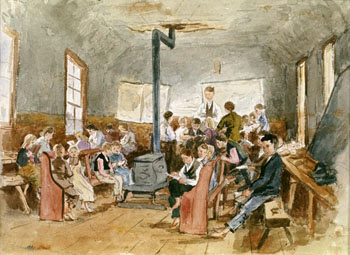PEI Teachers: A brief look at being a one-room school house teacher before 1852
Education. It is such an important part of our lives, we start at age 5/6 and continue through until we graduate high school, over ten years later. During these years, there are some fees. If any of you are parents or in school, you will have a better idea of those fees. For me, it has been a while! But, one thing we do not have to worry about in our public schools is paying tuition (university and private schools not included).
Today, we are going to look at one of the most important parts of our, well any, education system...Teachers! Specifically, what it was like to be a teacher on PEI before 1852 when the PEI Free Education Act passed (its full name was "An act for the encouragement of education, and to raise funds for that purpose, by imposing an additional assessment on land in this Island, and on real estate in Charlottetown and common, and Georgetown and common').
Before 1852, being a teacher on PEI meant a lot of job insecurity and some challenges that we might not think about.
Pay, or lack thereof
Pay, or lack thereof
Before 1852 Queens Country had the most schools (I think it is safe to assume they still do!), but only two-thirds of these were ever open at the same time! Like many issues, it came down to financial concerns. Island schools did not pay teachers well and sometimes their pay could be sporadic. Without a steady, living wage, good teachers were not drawn to Island schools. Those that did take up teaching often did not last long, other times, the teachers lacked morale which made them less effective. This lack of teachers was one of the key events that led to the 1852 PEI Free Education Act which placed the burden of paying teachers on the province rather than the community.
In general, teachers in rural areas were paid less than their urban counterparts, who had access to a larger population and therefore, more people to contribute to the school.
Women were seen as the ideal teachers for young children as they were more nurturing. However, they were supervised by men who saw themselves as the real teachers and were paid more. So remember that if you look into the history of education anywhere in Canada, men and women were treated very differently.
 |
| School at Canoe Cove, PEI by Robert Harris (Image Credit) |
Experience
Rural teachers usually did not have a lot of formal training. As stated above, more qualified teachers often left for more urban schools. This left some schools with the decision of either closing the school until a suitable teacher was found or filling the position with a less qualified teacher to keep the school open.
Trustees
Without government guidelines or standards, these early schools relied on their trustees to guide the school and hire teachers. For some schools, this was an issue. Now, if you are an adult reading this you likely remember the Rural Teacher Heritage Minutes. If not, here is the video:
The quality of education throughout the province varied, not only among students but among the parents and community members. Therefore, like in Rural Teacher, a teacher could end up with a school trustee or trustees, who couldn't read. This is not to say PEI was the only province with this issue. Education before 1852 was not up to the level we have now. As you will see in a future post, the PEI Free Education Act of 1852 had a large impact!
Marriage Expectation
For young women, teaching was often viewed (by them and society) as a short-term job that they would give up when they married.
Additional Duties
As rural schools ran on tight budgets, teachers were also expected to act as janitors and school-keepers.
The Schoolhouse
Rural one-room schoolhouses were simple structures and built based on what the community could afford or were able to build themselves. These schools were usually simple, consisting of one room and sometimes a small cloakroom/storage closet and a wood/coal stove for heat. These schools did not have electricity or indoor plumbing.
Sometimes, these schools did not have good ventilation, which could be an issue for schools heated by wood or coal stoves.
 |
| The Union Corner Schoolhouse. Build between 1860 - 1863 (Image Credit) |
Teaching
Teaching one grade is hard enough. Imaging teaching two, or three, or five, or in some cases, ten! One room schoolhouses placed students of varying ages in one room, all trying to learn.
Being a teacher is a tough career, but I think I can safely say teaching in the 1800's had some unique challenges.
If you like my blog please subscribe and share!
If you have any suggestions for posts, just let me know.
Sources:
Gaffield, Chad and Dominique Millette. "Teaching in Canada." Historica Canada. March 4, 2015. From http://www.thecanadianencyclopedia.ca/en/article/history-of-education/
Gilliss, Geraldine et al. "Teaching Profession." Historica Canada. December 16, 2013. From http://www.thecanadianencyclopedia.ca/en/article/teaching-profession/
"History of the Education Movement in the Colony." Legislative Assembly of Prince Edward Island. February 25, 2013. From http://www.assembly.pe.ca/index.php3?number=1042423
Robertson, Ian Ross. "Reform, Literacy and the Lease: The Prince Edward Island Free Education Act of 1852." Acadiensis 20.1 (Autumn 1990). pp. 52-71.
Wilcox, Michael. "Rural Teachers in Canada." Historica Canada. March 1, 2017. From http://www.thecanadianencyclopedia.ca/en/article/rural-teachers-in-canada/


Comments
Post a Comment